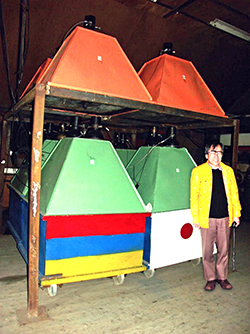YEREVAN — The first years of Armenia’s independence were very difficult for the staff at Yerevan Physicis Institute’s Cosmic Ray Division(CRD). With funding suddenly stopped from the largest soviet ministry, there was no fuel, electricity, or food. Monthly salaries were the equivalent to five U.S. dollars. The construction of the world’s largest cosmic ray experiment, ANI[1], remained half completed. Work on the detectors ceased, and a question arose: “Is it really necessary to continue this research on Aragats? Will it be possible?” How could our research stations keep working on Mt. Aragats’ severe high-mountain winter conditions?
After a year of shock, CRD physicists adopted a realistic program for future research. They would continue measurements of high-energy cosmic rays, establishing new research directions where CRD could be a world leader.They would conduct research which would not require abundant funds for conducting expensive, gigantic experiments. The key part of this program was CRD’s participation in international projects, submitting proposals for international funding, and establishing close ties with the Armenian diaspora in the USA.
During the initial five years this continuous effort produced positive results. In collaboration with Russia’s Lebedev institute, two arrays of particle detectors to measure extensive air showers of cosmic ray particles was completed. These systems, named “GAMMA” and “MAKET ANI”, consisted of three hundred scintillation detectors. It became operational with new modern electronics. These detectors measured the faint flashes of light created by individual cosmic ray particles, or their byproducts, as they passed through a special clear plastic-like material.
CRD participated in a world-wide collaboration with Japan’s Nagoya University, and the German nuclear centers at Karlsruhe and the Max Plank Instutute Fur Physics in Munich. CRD physicists won grants totaling $2.5 million . New particle detectors were designed, fabricated and purchased by collaborators. Modern software for data storage and making physical inferences was created. Neutron monitors were operated with modern electronics at Nor Ambert and Aragats research stations on Mt. Aragats at 2.0 km and 3.2 km altitude respectively.
In the new scientific arena of solar physics and space weather research, CRD physicists produced rapid results, making important measurements, publishing their initial scientific papers, and joining the International Heliophysical Year (IHY) – the UN’s agency of outer space research. CRD participated as a leading group developing networked particle detectors to be installed in developing countries. This was one of the most successful IHY programs and it is continuing, with SEVAN[2] nodes located in Armenia, Bulgaria, the Czech Republic, Croatia, Germany and Slovakia with a total of 10 detectors.
In 2008 CRD scientists discovered characteristics and mechanisms of short particle bursts of radiation and long-lasting particle multiplication and acceleration produced within thunderstorms (Thunderstorm Ground Enhancements – TGEs). They were the first to measure the energy spectra of electrons and gamma rays from particle avalanches of atmospheric origin that reach the Earth’s surface. This was a new scientific direction, namely High-Energy Physics in the Atmosphere (HEPA), which. studies various physical processes extending many cubic kilometers into the atmosphere.


Also, for the first time, CRD scientists observed the light glows emitted during the development of electron-gamma ray cascades in the atmosphere, which was well correlated with the high-energy electron flux registered by surface particle detectors. Thus, they first specified TGE phenomena by detecting simultaneous fluxes of high energy electrons, gamma rays, and neutrons; then they observed Relativistic Runaway Electron Avalanches (RREA) by detecting particle showers coming from the clouds. Subsequently they proved the existence of the lower dipole that accelerated electrons towards the Earth’s surface. Simulations of electron propagation in the strong atmospheric electric fields, and estimations of the maximum voltage drop in the charged atmosphere, proved the origin of this phenomena. Only then did CRD present a comprehensive model of TGEs and evidence of RREA’s origination in the atmosphere. Simultaneously Bulgaria, Croatia, Czech Republic, Germany, and Slovakia, all using SEVAN detectors, contributed to a better understanding of the variations of secondary cosmic rays. They also contributed to the study of vertical profile in electron-positron and gamma components produced during thunderstorms.
CRD’s SEVAN detectors are unique devices that can observe the modulation of particle fluxes due to violent outbursts from the Sun, forecast dangerous consequences of space weather, and perform wide research programs in the fundamental aspects of atmospheric physics.
Now research on Aragats encompasses the most interesting aspects in the fast-developing atmospheric, solar, and high-energy physics. This includes: cosmic ray origins and acceleration mechanisms; solar-terrestrial connections; solar modulation of galactic cosmic rays; space weather; acceleration of particles on the sun; high-energy physics in the atmosphere; lightning physics; and scientific instrumentation and multivariate data analysis.
Particle fluxes measured by spatially scattered networks, combined with information from satellites, provides experimental data on the most energetic processes on the Sun and in the Earth’s atmosphere. This will become an important element of global space weather monitoring and forecasting services. Rich multivariate visualization and analytic capabilities developed by CRD are indispensable for further scientific progress.
Thus, research at CRD synergistically connects cosmic solar physics and high-energy atmospheric physics. This exchange of ideas results in the identification of conditions that produce violent particle bursts in the atmosphere, which are associated with dangerous processes affecting the Earth’s environment.










